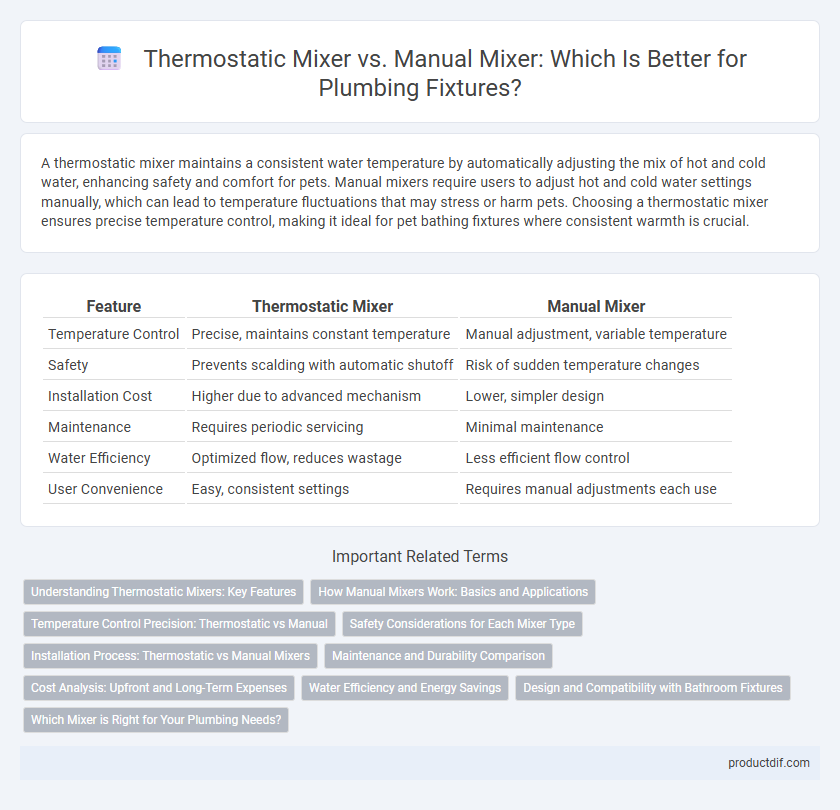A thermostatic mixer maintains a consistent water temperature by automatically adjusting the mix of hot and cold water, enhancing safety and comfort for pets. Manual mixers require users to adjust hot and cold water settings manually, which can lead to temperature fluctuations that may stress or harm pets. Choosing a thermostatic mixer ensures precise temperature control, making it ideal for pet bathing fixtures where consistent warmth is crucial.
Table of Comparison
| Feature | Thermostatic Mixer | Manual Mixer |
|---|---|---|
| Temperature Control | Precise, maintains constant temperature | Manual adjustment, variable temperature |
| Safety | Prevents scalding with automatic shutoff | Risk of sudden temperature changes |
| Installation Cost | Higher due to advanced mechanism | Lower, simpler design |
| Maintenance | Requires periodic servicing | Minimal maintenance |
| Water Efficiency | Optimized flow, reduces wastage | Less efficient flow control |
| User Convenience | Easy, consistent settings | Requires manual adjustments each use |
Understanding Thermostatic Mixers: Key Features
Thermostatic mixers maintain a precise water temperature by automatically adjusting the balance of hot and cold water, ensuring user safety and comfort. These fixtures feature built-in temperature sensors and automatic shut-off mechanisms to prevent scalding and thermal shock. Unlike manual mixers, thermostatic mixers provide consistent water temperature regardless of pressure fluctuations, making them ideal for modern plumbing systems in residential and commercial settings.
How Manual Mixers Work: Basics and Applications
Manual mixers operate by controlling hot and cold water flows separately, allowing users to adjust temperature and flow rate through individual knobs or levers. These fixtures rely on user skill to maintain desired water temperature, making them suitable for applications where precise temperature control is less critical. Commonly installed in residential bathrooms and kitchens, manual mixers offer simplicity and cost-effectiveness but lack the safety features of thermostatic mixers that prevent scalding.
Temperature Control Precision: Thermostatic vs Manual
Thermostatic mixers provide precise temperature control by automatically adjusting water flow to maintain a consistent temperature, reducing the risk of scalding or sudden temperature changes. Manual mixers require users to adjust hot and cold water valves manually, often resulting in fluctuating temperatures and less accuracy. The advanced temperature regulation capability of thermostatic mixers enhances safety and comfort in plumbing fixtures compared to manual mixers.
Safety Considerations for Each Mixer Type
Thermostatic mixers maintain a consistent water temperature by automatically adjusting hot and cold water flow, significantly reducing the risk of scalding and thermal shock, which is crucial in households with children or elderly individuals. Manual mixers require users to adjust the water temperature manually, increasing the potential for accidental burns due to sudden temperature fluctuations. Installation of thermostatic mixers is often recommended in environments where safety regulations mandate temperature control to prevent injuries.
Installation Process: Thermostatic vs Manual Mixers
Thermostatic mixers require precise installation involving temperature sensors and thermostatic cartridges to maintain consistent water temperature, often demanding professional expertise. Manual mixers have a simpler installation process, typically involving fewer connections and no temperature regulation components, making them more straightforward for DIY setups. Proper sealing and adherence to manufacturer guidelines are essential in both to prevent leaks and ensure optimal performance.
Maintenance and Durability Comparison
Thermostatic mixers require less frequent maintenance due to their built-in temperature regulation mechanisms that reduce wear on internal components, significantly extending their durability compared to manual mixers. Manual mixers often experience faster deterioration from frequent manual adjustments, leading to increased chances of leaks and valve wear over time. High-quality thermostatic mixers, constructed from corrosion-resistant materials, provide superior longevity and consistent performance in plumbing fixtures.
Cost Analysis: Upfront and Long-Term Expenses
Thermostatic mixers typically have higher upfront costs due to advanced temperature control technology but offer long-term savings by reducing water and energy consumption through precise regulation. Manual mixers, while initially cheaper, can lead to increased utility bills and potential maintenance expenses due to inconsistent temperature control and increased wear over time. Evaluating total cost of ownership reveals thermostatic mixers provide better value for residential and commercial plumbing fixtures through enhanced efficiency and durability.
Water Efficiency and Energy Savings
Thermostatic mixers maintain a consistent water temperature, reducing water wastage by minimizing the need for manual adjustments, which enhances water efficiency compared to manual mixers. These devices also optimize energy savings by preventing unnecessary heating or cooling cycles, ensuring hot water is used more efficiently. Manual mixers often lead to increased water and energy consumption due to fluctuating temperatures and prolonged adjustment times.
Design and Compatibility with Bathroom Fixtures
Thermostatic mixers feature sleek, modern designs that seamlessly integrate with contemporary bathroom fixtures, offering precise temperature control and enhanced safety. Manual mixers often have simpler, traditional aesthetics that may not complement high-end or minimalist bathroom styles as effectively. Compatibility varies as thermostatic mixers require specific plumbing setups, whereas manual mixers offer broader adaptability with various fixture types and existing bathroom installations.
Which Mixer is Right for Your Plumbing Needs?
Thermostatic mixers maintain a consistent water temperature by automatically adjusting hot and cold water flow, enhancing safety and comfort in bathrooms and kitchens. Manual mixers require users to adjust temperature manually, offering simplicity and lower initial cost but less precise control. Choosing between thermostatic and manual mixers depends on priorities like temperature regulation, safety features, and budget considerations for your plumbing system.
thermostatic mixer vs manual mixer Infographic

 productdif.com
productdif.com